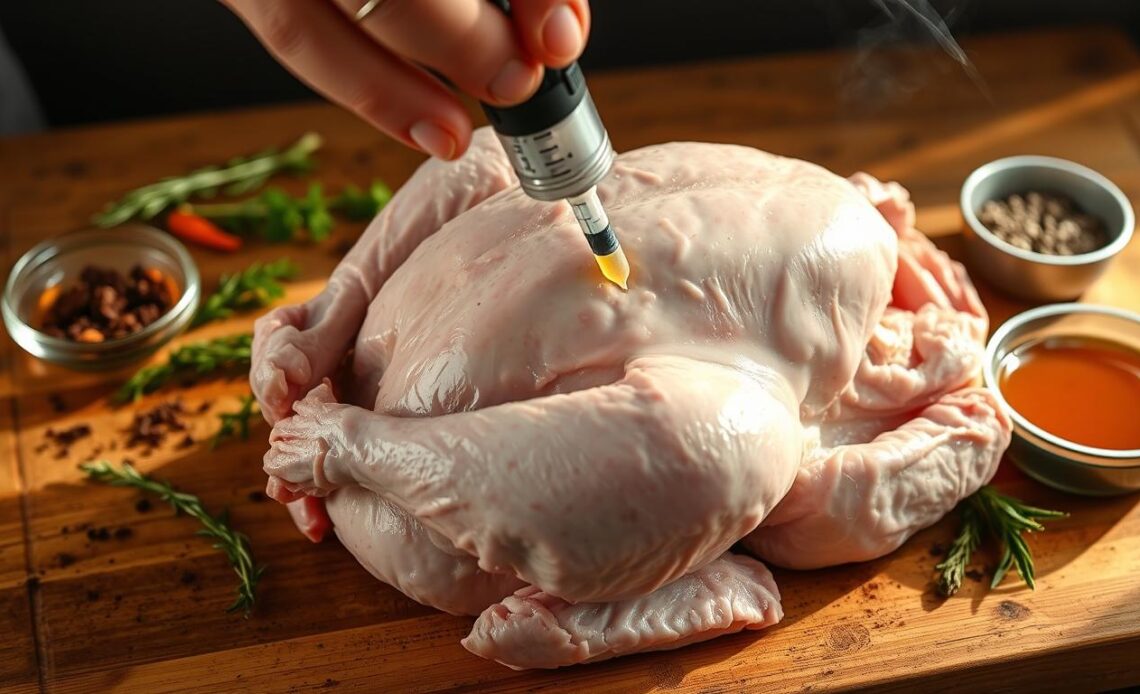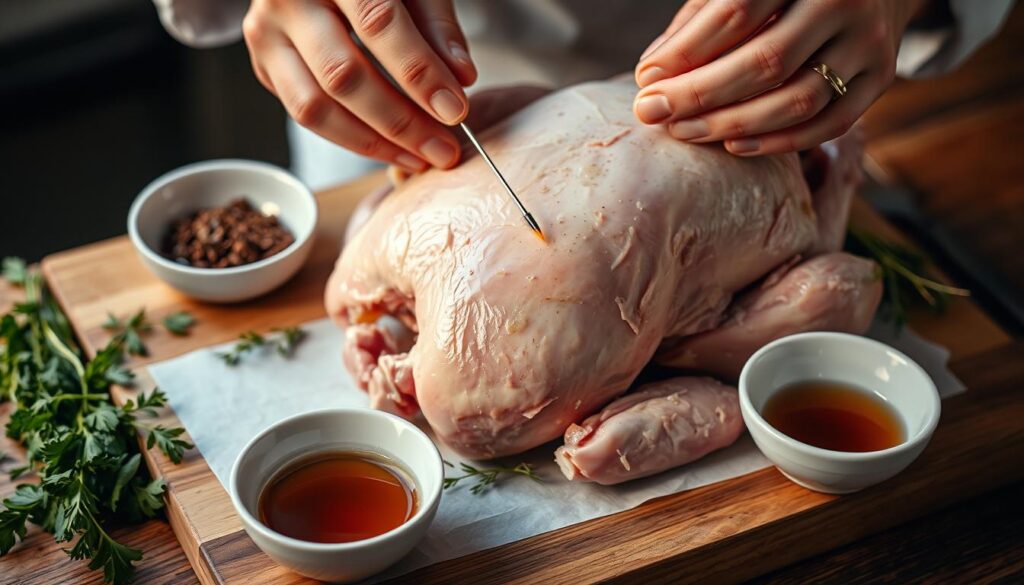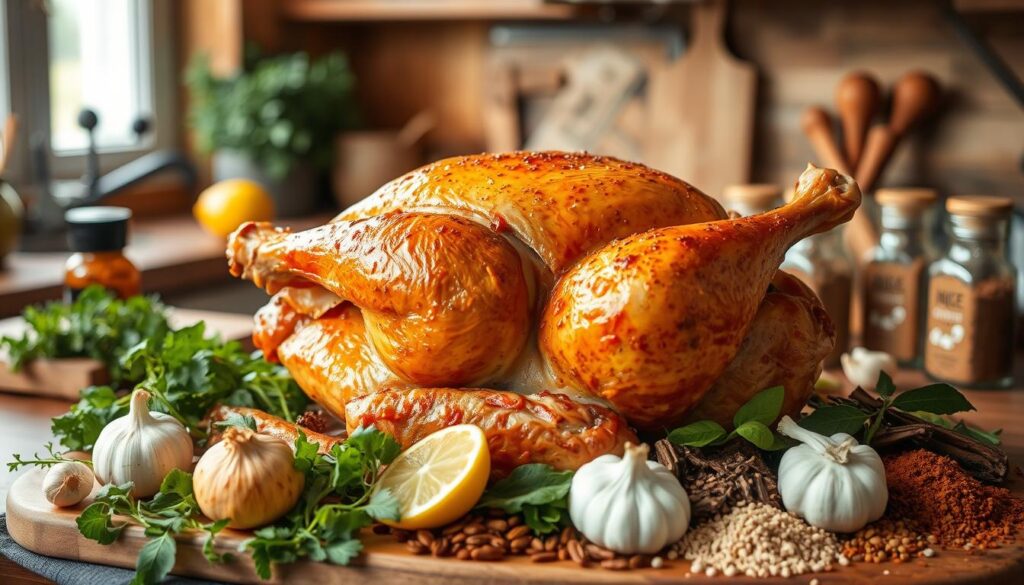
You know that warm, honest feeling when everyone leans in as you pull the bird from the oven. That moment matters. You want every bite to remind them of home, not dry meat and stress.
Injecting keeps flavorful liquid inside the bird, reaching places a surface marinade can’t. It helps the meat stay moist even when cooking takes longer than planned.
You can inject right before cooking or up to 24 hours ahead. Aim for about 1 ounce per pound, and use real ingredients like butter and broth for rich, balanced flavors.
Key Takeaways
- Injecting pushes flavor deep into the meat where marinades don’t reach.
- Plan about 1 ounce of liquid per pound for consistent results.
- Make your own mix with butter, broth, and herbs for better taste and value.
- You can inject before cooking or up to a day ahead for flexibility.
- Works whether you roast, smoke, or fry—keep tools clean and simple.
Make your Thanksgiving turkey unforgettable with a buttery injection
Start with a warm, buttery blend that carries flavor and moisture right into the meat. Melt unsalted butter and whisk in chicken broth, a splash of lemon juice, a dash of hot sauce, onion and garlic powder, and salt until smooth.
Keep the mix at room temperature or a bit warmer so melted butter stays emulsified and won’t separate. Place the bird on a tray to catch leaks and keep your workspace tidy.
Work section by section. Inject slowly and watch the interior plump as liquid disperses — that gentle swelling shows the mix reached the right spots.
- Melted butter is the richest carrier for moisture and taste.
- A splash of lemon juice and a touch of hot sauce brighten the profile without heat.
- Warm ingredients blend smoothly and save you time when loading the injector.
This simple set of ingredients uses pantry staples to protect lean pieces while you roast, smoke, or fry. The result is a juicier, richer bird that still leaves room for gravy and sides to shine.
Why inject turkey instead of just marinating or brining
When you need guaranteed flavor deep inside thick cuts, injecting beats a surface soak every time.
Deep flavor where marinades can’t reach. A typical marinade only soaks about 1 cm into the meat, leaving the center mild on large pieces. By placing liquid inside, you season the interior so every slice carries taste, not just the crust.
Moisture insurance for lean breast meat. Breast portions dry out faster than dark meat. A small amount of broth- or butter-based liquid inside the muscle helps it self-baste as it cooks. That keeps slices tender and moist from edge to edge.
Practical benefits
- Marinades struggle to get past the outer layer, so injecting is the way to carry flavor into the center.
- Injection works immediately, so you can do this even when you’re short on time.
- If you brine and inject, reduce salt in the injectate to avoid over-seasoning.
- It complements your rubs and other recipes by seasoning the interior while your skin forms a crisp crust.
Tools you need to inject turkey at home
Set up a clean station with the tools you need so each step takes only a few minutes. Working tidy keeps the process safe and stress-free when you handle meat.
Stainless steel injector and needle options
Choose a sturdy stainless steel injector that is easy to disassemble and won’t fail after a few uses. Pick needle styles to match your mix: side-port needles spread thin liquids, open-tip needles pass thicker blends.
Keep spare O-rings or washers on hand — make sure seals stay tight or leaks will slow you down.
Tray, sieve, and thermometer for a clean workflow
Set the bird on a rimmed tray to catch drips and keep counters clean. Strain your blend through a fine mesh sieve so herbs don’t clog the needle mid-use.
Use an instant-read thermometer to check 165°F in the breast for safe, juicy results. Keep the injectate at room temperature so it flows smoothly and you can reload the syringe in minutes.
- Opt for dishwasher-safe parts, but rinse right away to avoid hardened residue.
- Have paper towels ready to wipe the needle between spots and prevent cross-contamination.
Core ingredients for a flavorful turkey injection
Begin by choosing a carrier that moves easily and adds body, like melted butter or a neutral oil. The carrier helps the rest of your ingredients slide through the meat and hold moisture as it cooks.
Butter or oil as the carrier
Butter adds richness and a silky mouthfeel. Use melted butter for classic taste or a neutral oil if you want a dairy-free option.
Broth, lemon juice, and hot sauce for balance
Build body with chicken broth and a spoonful of concentrated chicken base for savory depth. A splash of lemon brightens the mix, and a dash of hot sauce lifts the overall flavor without heat.
Garlic, onion, herbs, and base for depth
Keep garlic and onion powder light and add herbs like thyme or sage. Strain the mix so solids don’t clog your needle.
- Plan around a cup or two of liquid for a whole bird.
- Use Better Than Bouillon for an easy savory boost.
- Season lightly if you brine to avoid over-salting.
“A smooth, well-balanced injectate carries flavor into places a surface rub can’t reach.”
| Carrier | Flavor Add-ins | Notes |
|---|---|---|
| Butter | Garlic, thyme, lemon | Rich, classic; cool slightly before loading |
| Neutral oil | Chicken broth, onion powder, hot sauce | Dairy-free; thinner flow through needle |
| Broth base | Better Than Bouillon, herbs | Adds umami and depth without extra fat |
Turkey injection recipe (step-by-step)
Follow this step-by-step guide to make a smooth, flavorful injectate and load your syringe with confidence.
Melt and combine the base
Gently melt one stick of unsalted melted butter in a small saucepan. Whisk in 1 cup chicken broth, 2 tbsp lemon juice, and 1 tbsp hot sauce until the mix looks unified.
Season and simmer
Add 1 tsp onion powder, 1 tsp garlic powder, 1 tsp salt, and a spoon of concentrated chicken base if you like deeper savor. Simmer for about 5 minutes to bloom the spices and marry the flavors.
Steep, cool, and strain
Remove from heat and let the blend steep so it mellows. Cool to room temperature before handling—this keeps the fat from seizing and prevents clogs.
- Strain through a fine mesh sieve to catch solids.
- Place the bird on a rimmed tray to catch drips.
- Load the injector, tap out air bubbles, and keep a clean cup nearby between fills.
Taste a small drop and tweak salt or lemon as needed. Work calmly — in just a few minutes your ingredients will be ready and you can begin the injection process with steady, even strokes.
How to inject a turkey for even, juicy flavor
Aim for deep placement at the thickest muscle first, then fan out with angled passes. This way gives broad coverage with fewer holes and keeps the skin looking clean.

One‑hole, many‑angles method
Insert the needle fully into the breast, then withdraw slowly while you press the plunger. That fills pockets of liquid along the track instead of leaving a single tunnel.
Use one entry point and change angles to hit different muscle groups. This reduces visible punctures and covers more interior real estate in the bird.
Go slow on the plunger and watch for plumping
Steady, slow pressure prevents leaks and forces the liquid into the fibers. You’ll see the surface gently plump when the shot lands in the right spot.
Work both sides of the breast first, then move to thighs and drumsticks so dark meat gets even attention.
Wipe excess, then season the skin before cooking
If fluid seeps out, simply change angle and keep going. Wipe droplets from the skin and pat the surface dry before applying your rub.
- Reload the injector as needed and avoid air pockets for consistent flow.
- Use a tray to catch drips and rotate the bird as you go.
- If the needle clogs, rinse it quickly with warm broth and continue.
Pro tip: Finish by seasoning the skin so interior injection and exterior rub work together for balanced flavor.
Timing, amounts, and brining considerations
Give the bird a little time after shots so the liquid can migrate and settle inside the muscles. That rest helps flavors even out and gives you more predictable results when you carve.
How much to make: Plan about 1 ounce per pound — roughly 1–2 cups for a whole turkey. That gives you enough to hit the breast and dark meat in multiple passes without running short.
When to inject and rest
You can inject right before cooking or up to 24 hours ahead. If you have the hours, an overnight rest lets the mix disperse more evenly.
Brine and seasoning balance
If you wet brine or use a heavy dry rub, reduce the salt in your injectate so the final taste stays balanced. Match flavors to your favorite recipes and tweak salt sparingly.
Temperature tips
Keep the injectate at room temperature so it flows cleanly through the needle and avoids clogs. Working in a cool room is fine, but avoid cold liquids that thicken and slow you down.
- Split the total across multiple passes to cover breast and thighs evenly.
- Pat the skin dry before and after shots to protect browning.
- Work on a tray so you can rotate the bird and track time without mess.
Flavor variations to make it your own
Small swaps in your injectate can turn a classic roast into a bold, new centerpiece. Pick one profile or mix elements to match your menu. Keep blends smooth and strainable so the needle never clogs.

Cajun kick with Creole spice
Build a zesty mix around Creole seasoning and a touch of cayenne for a true cajun turkey hit. Balance heat with a little butter or broth so the flavor spreads without overpowering sides.
Apple cider and herb warmth
Use apple cider as a sweet-tart base, then fold in fresh thyme and sage. This gives a fall-forward, comforting profile that pairs well with stuffing and gravy.
Lemon-garlic butter brightener
For a brighter voice, combine lemon, garlic, melted butter, and a spoon of white wine vinegar. The acid lifts richness and keeps slices tasting fresh.
Pro tweaks for depth
Add a spoon of Better Than Bouillon or a tiny pinch of MSG to heighten savory notes. A splash of whiskey adds warmth that works with smoked or oven-roasted birds.
Tip: Match seasoning intensity to your skin rub so inside and outside flavors complement each other.
Cook it right: roasting, smoking, or frying your injected bird
Choose the cooking method that fits your kitchen and timeline—roasting, smoking, or frying each bring different benefits.
After you inject, pat the skin dry and season the outside so the crust matches the juicy interior.
Monitor temperature closely. Use an instant-read thermometer and pull the bird when the breast reaches 165°F. Resting allows carryover heat to finish cooking and keeps slices moist.
Spatchcocking is a fast way to cut minutes and get even browning on both sides. A whole turkey needs more fills and care than a breast-only cook, which cooks faster and takes fewer passes.
Practical checks for every way of cooking
Roasting gives classic crisp skin. Smoke adds depth over low heat. Frying locks in juices and creates a crisp exterior fast.
If you use garlic in your rub, it echoes the flavors you placed inside the meat. For frying, confirm oil temperature is steady before lowering the bird.
- Pat skin dry, then season for a tasty crust.
- Pull at 165°F in the breast and allow rest for juices to settle.
- Spatchcock to save minutes and promote even cook time.
- Take notes on timing and temperature so your next cook is tighter.
Tip: Injected birds often stay juicy even if you go a bit past target temperature, but aim for 165°F for safety and best texture.
Food safety, storage, and troubleshooting
Food safety starts the moment your needle pierces raw meat—treat anything it touched as contaminated. Set a clean work area, use a tray for drips, and keep a fresh bowl of sauce set aside before you begin.
Discard contaminated leftovers and keep injectate clean
The moment your needle touches raw bird, anything left in the injector or bowl is contaminated. Discard leftover liquid and wash parts thoroughly. Dishwasher-safe stainless injectors are handy; keep spare washers and seals so performance stays reliable.
Clogged needle fixes
If the needle feels tight, strain the blend through a finer sieve. Thin thick mixes with warm broth or a splash of oil so flow returns in seconds. Warming chilled injectate to room temperature helps for smooth shots.
Too salty or too mild: quick balance tips
If you brined, cut back on salt in the injectate. Taste and adjust by adding a bit more butter, chicken base, or acid until the sauce brightens. Work efficiently—set a timer for any brief simmering minutes and toss anything that touched raw poultry.
| Issue | Quick Fix | Why it helps |
|---|---|---|
| Clogged needle | Strain finer; thin with warm broth | Removes solids and lowers viscosity |
| Contaminated injectate | Discard; mix fresh portion | Prevents foodborne illness |
| Too salty | Reduce salt next batch; add butter or acid | Rebalances savory notes without masking flavor |
Conclusion
,
A quick at-home technique gives you moist, well-seasoned meat with minimal fuss.
Use a simple injection recipe built from butter or oil, broth, and a touch of acid. Make sure the mix is smooth, well strained, and kept at room temperature so it flows easily.
Aim for about one ounce per pound and inject turkey right before cooking or up to 24 hours ahead to let flavors settle. Keep outside seasoning light so the interior and skin balance nicely.
Works for roasting, smoking, or frying. Discard any mixture that touched raw poultry and adjust salt, butter, or lemon to match your taste. With pantry ingredients and a steady hand, you’ll serve a memorable thanksgiving turkey at home.

